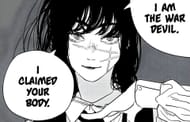In Tatsuki Fujimoto's Chainsaw Man, the War Devil Yoru stands out as a peculiarly written character whose apparent lack of sophistication initially seems at odds with the strategic nature of warfare itself. While other primal fears in the series manifest as calculating entities - such as Makima's embodiment of Control and Fami's representation of Famine - Yoru's often impulsive and seemingly naive approach to conflict appears counterintuitive.
However, this apparent contradiction may be a deliberate commentary on how modern society perceives and fears war, particularly in the context of post-World War II conflicts and the evolution of warfare in contemporary consciousness.
Disclaimer: The opinions expressed in the article solely belong to the author.
Yoru and the evolution of warfare in Chainsaw Man: From strategy to senseless destruction
The contrast between Yoru's personality and traditional concepts of warfare is striking. While warfare historically embodies strategic thinking, careful planning, and tactical execution - as famously outlined in Sun Tzu's "Art of War" - Yoru frequently displays impulsiveness and lack of forethought. This disparity becomes particularly evident in her sharing a body with a teenager whose immediate response to attraction is crafting spontaneous poetry.
Yet, this apparent mismatch may be precisely what Fujimoto aims to convey. Yoru's arsenal and combat style heavily favor modern weaponry, with her introduction featuring the transformation of a spinal cord into a sword, ultimately culminating in a "guts grenade" as the decisive weapon.
This preference for contemporary instruments of war reflects society's current fears about modern warfare - not of strategic conflicts between clear adversaries but of senseless violence driven by arbitrary decisions and political whims. Her powers seem to manifest most strongly when they align with modern military technology, suggesting a direct connection to contemporary anxieties about mechanized warfare and weapons of mass destruction.
Also read: The Blood Fiend may already be back in Chainsaw Man, but not how fans want
Chainsaw Man’s take on justified conflict

The absence of Nazis in the Chainsaw Man universe provides another crucial layer to this interpretation. Their non-existence suggests a dramatically altered World War II or its complete absence from history. This omission is significant because World War II often represents the concept of a "justified war" in popular consciousness.
Without this moral framework, the remaining significant conflicts in recent memory - particularly for American audiences - would be more controversial engagements like the Vietnam War, which often epitomize the senselessness of modern warfare.
The chaos of modern warfare in Chainsaw Man
The Gun Devil's awakening further reinforces this theme of purposeless destruction through the obliteration of the Statue of Liberty - a symbolic act that only facilitates a brief battle elsewhere. Similarly, the Aging Devil's motivation for fighting Chainsaw Man stems from a petty desire to witness child mortality, emphasizing the often arbitrary nature of modern conflicts.
Also read: Asa and Yoru, not the octopus devil, may be the true key to Yoshida's plan in Chainsaw Man
These elements combine to create a narrative where violence exists not in service of grand strategies or noble causes but as expressions of spite, convenience, or simple destructive urges. Moreover, Yoru's interactions with other characters often highlight the disconnect between traditional warfare's strategic elements and modern warfare's often chaotic nature.
Her straightforward, sometimes brutish approaches to problems reflect a world where military might is often applied without clear objectives or consideration of consequences. This characterization serves as a critique of how modern warfare has evolved from strategic necessity to what many perceive as tools of political whim or economic interest.
Conclusion
The interpretation of Yoru as an embodiment of senseless war rather than strategic warfare explains her seemingly illogical behavior and decision-making. Her character reflects society's evolved fears about war - not of brilliant strategists orchestrating complex campaigns but of capricious violence unleashed by those disconnected from its consequences.
This reading of Yoru's character deepens our understanding of how Fujimoto's work engages with contemporary anxieties about warfare and violence, suggesting that our greatest fear isn't of war's tactical complexity but of its potential for meaningless destruction and suffering.
Also read:
- Chainsaw Man fans say "welcome back, Makima" after Yoru's latest offer to Denji
- Pochita's effect on other Devils' abilities teases his true identity
- Hidden detail of Pochita's powers may explain how he weakened Yoru in Chainsaw Man
- Denji has developed in Chainsaw Man, even if his actions say otherwise
